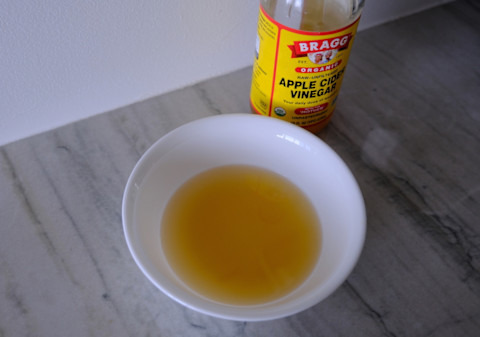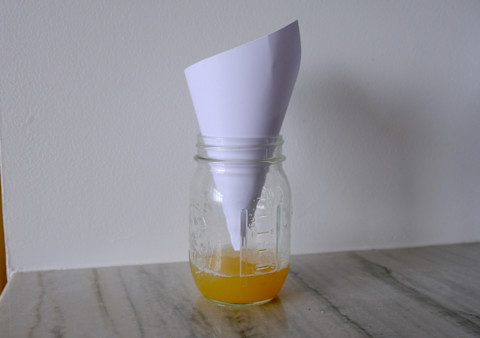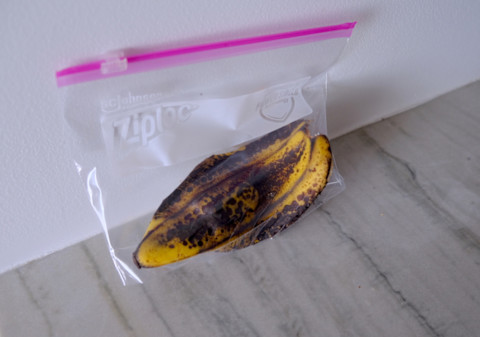
Fruit flies prove that sometimes it's the smallest things that are the most irritating. These teeny-tiny pests have a way of quickly taking over otherwise peaceful kitchens, and they can be quite the nuisance to home cooks. Here's what to know about what causes fruit flies, how to get rid of them quickly, and how to prevent them in the future.
DIY traps to try at home
Once you have fruit flies at home, the key to getting rid of them is setting out their favorite ingredients—rotting food or fermented products—as bait and then trapping them before they can escape. Luckily, fruit flies are not the most intelligent of critters, and this is usually pretty easy to do.
Don't have a store-bought trap on hand? No problem. You can quickly get rid of fruit flies using materials you already have in your kitchen with these six homemade traps:
Apple cider vinegar and dish soap
Kris Bordessa, a green living expert and the author of Attainable Sustainable: The Lost Art of Self-Reliant Living, notes that the apple cider vinegar in this DIY trap lures the fruit flies, while the soap reduces the surface tension of the vinegar and effectively traps them.

Materials:
- A small bowl
- Apple cider vinegar
- Dish soap
- Plastic wrap
- Scissors or something sharp
Method:
- Fill your bowl about halfway with apple cider vinegar. Then, add a few drops of soap.
- Place plastic wrap over your bowl and secure it tightly. Poke a few holes in the plastic wrap so the flies can get in. (Getting out will be more difficult, thanks to the soap.)
- Place the bowl in the area where you see fruit flies.
- Once the bowl has trapped a number of flies, empty it in the trash and immediately take it out. If necessary, you can repeat the process again to get any leftover flies.
Mason jar and a paper funnel
Environmental journalist and author of Humane Home: Easy Steps for Sustainable & Green Living Sarah Lozanova uses this method in her home kitchen and has been impressed by how many flies it can trap at once. The key is making your paper funnel opening very small at the bottom but wide at the top so the flies can get in easily but have trouble getting out.

Materials:
- A wide-mouth Mason jar
- Thick paper
- Tape
- A banana peel or apple cider vinegar
Method:
- Place some bait in your wide-mouth jar: Apple cider vinegar or a banana peel will both attract the critters.
- Form a funnel out of a thick piece of paper, and stick it in the jar so the small side sits well below the jar opening.
- Tape the funnel to the jar so it stays in place.
- Place the jar in the area where you see fruit flies.
- Once you have caught flies, empty the jar outside your home. If necessary, you can repeat the process again to get any leftover flies.
A glass of red wine
Ever the boozers, fruit flies always seem to find their way to a good glass of red, Bordessa notes. You can use their love of fermented grapes to your advantage by making a quick trap out of off or unsavory wine.
Materials:
- A small bowl
- Red wine you're not planning to drink
- Dish soap
- Plastic wrap
- Scissors or something sharp
Method:
- Fill your bowl about halfway with wine. Then, add a few drops of soap.
- Place plastic wrap over your bowl, and secure it tightly. Poke a few holes in the plastic wrap so the flies can get in.
- Place the bowl in the area where you see fruit flies.
- Once the bowl has trapped a number of flies, empty it into the trash and immediately take it out. If necessary, you can repeat the process to get any leftover flies.
Banana and a plastic bag
Bordessa notes that this simple trap is also an easy way to reuse plastic bags and reduce waste in your kitchen.

Materials:
- A used plastic bag
- A banana peel
- Scissors or something sharp
Method:
- Place a banana peel inside a lightly used plastic bag.
- Close the bag most of the way, but leave a small opening for fruit flies to enter.
- Place the bag in the area where you see fruit flies.
- Once you have caught flies, empty the bag outside your home or throw it in the trash and immediately take it out. If necessary, you can repeat the process again to get any leftover flies.
Peppermint or thyme essential oils
According to one 2016 study in Scientific Reports1, the smell of certain essential oils can be off-putting and, in some cases, deadly to fruit flies. Peppermint and thyme oil were the best at preventing and killing pests in this study.
You can put this research to work by diffusing essential oils in your kitchen to create an inhospitable environment for fruit flies to continue reproducing. At the very least, it will make your space smell nice.
Materials:
- An essential oil diffuser
- Water
- Peppermint and/or thyme essential oils
Method:
- Set up your diffuser near where you see fruit flies.
- Add water to its fill line and drop in three to five drops of peppermint and/or thyme essential oils.
- Run the diffuser for two to four hours, until the scent of the oils begins to fade.
A vacuum
Desperate times call for desperate measures, and if your fruit fly problem has gotten really annoying, Bordessa has heard of people simply sucking up flies with a vacuum.
What causes fruit flies in the first place?
Fruit flies, Drosophilidae, are a family of flies that are attracted to acetic acid, ethylene gas2, and carbon dioxide3 emitted by rotting produce and fermented products like apple cider vinegar and wine. Fruit flies will lay their eggs on these food sources and get into our homes that way.
"If you bring home bananas that have fruit fly eggs and they're sitting on your counter, given enough time they're going to hatch and be in your house," explains Bordessa.
These hatched flies are harmless, but they can quickly reproduce on any food source they find. "Once they come into the home, they can spread and start breeding and feeding on other types of produce," says Lozanova.
Fruit flies typically only live for one to two weeks, and if they can't find a place to reproduce in that time, they die off.
Preventing fruit flies in the future
Once you've set up these natural pesticides, the key to keeping fruit flies out of your home for good is to get rid of anything they may see as food. That way, even if they do find their way into your home again, they won't have anywhere to reproduce and will quickly die off.
Store your produce properly, and don't let it rot
Keep rotting fruits and vegetables covered and off your counters. Better yet, keep your produce from rotting in the first place by properly storing it to preserve freshness and eating it up quickly.
Regularly take out garbage and compost
Trash piles and full compost bins can also be breeding grounds for hungry, moisture-loving fruit flies. Take out your trash regularly and place your compost bin outside or in your freezer to keep the pests at bay.
Lozanova notes that dirty counters and drains can also harbor flies. Be sure to get in the habit of keeping your kitchen clean and fishing food out of your sink after washing dishes.
Wash fresh produce as soon as you get home
Rinsing off your produce—even things with peels you don't eat like oranges and bananas—as soon as you bring them home can help wash away any fruit fly eggs before they have the chance to hatch.
Wipe up standing water
Since fruit flies gravitate toward moist areas, Lozanova recommends being vigilant about keeping your kitchen dry and tackling any leaks and spills right away. "This is good for other reasons related to air quality," she adds.
If all else fails, look to your houseplants
If you've set all the traps and taken all the precautions and are still finding annoying critters in your kitchen, Bordessa notes that they might not be fruit flies. Instead, they could be fungus gnats coming from your houseplants. Check your greenery for signs of pests and treat them with neem oil if they have an infestation.
The bottom line
A few common household ingredients can go a long way in getting rid of fruit flies. If the issue persists, you'll want to call an exterminator to come and take a look. But with any luck, a little apple cider vinegar or funky wine will be all you need to clear the air at home.
